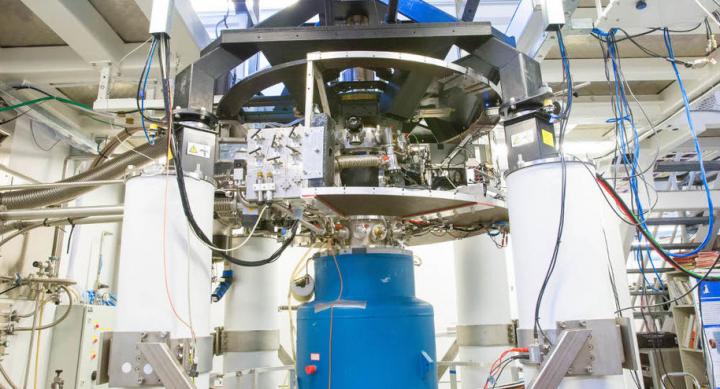First ever observation of ‘time crystals’ interacting

The rotating refrigerator at Aalto University
Credit: Aalto University/Mikko Raskinen
For the first time ever, scientists have witnessed the interaction of a new phase of matter known as “time crystals”.
The discovery, published in Nature Materials, may lead to applications in quantum information processing because time crystals automatically remain intact – coherent – in varying conditions. Protecting coherence is the main difficulty hindering the development of powerful quantum computers.
Dr Samuli Autti, lead author from Lancaster University, said: “Controlling the interaction of two time crystals is a major achievement. Before this, nobody had observed two time crystals in the same system, let alone seen them interact.
“Controlled interactions are the number one item on the wish list of anyone looking to harness a time crystal for practical applications, such as quantum information processing.”
Time crystals are different from a standard crystal – like metals or rocks – which is composed of atoms arranged in a regularly repeating pattern in space.
First theorised in 2012 by Nobel Laureate Frank Wilczek and identified in 2016, time crystals exhibit the bizarre property of being in constant, repeating motion in time despite no external input. Their atoms are constantly oscillating, spinning, or moving first in one direction, and then the other.
An international team of researchers from Lancaster, Yale, Royal Holloway London, and Aalto University in Helsinki observed time crystals by using Helium-3 which is a rare isotope of helium with one missing neutron. The experiment was carried out in Aalto University.
They cooled superfluid helium-3 to within one ten thousandth of a degree from absolute zero (0.0001K or -273.15°C). The researchers then created two time crystals inside the superfluid, and allowed them to touch.
The scientists observed the two time crystals interacting and exchanging constituent particles flowing from one time crystal to the other one, and back – a phenomenon known as the Josephson effect.
Time crystals have great potential for practical applications. They could be used to improve current atomic clock technology – complex timepieces that keep the most accurate time that we can possibly achieve. They could also improve technology such as gyroscopes, and systems that rely on atomic clocks, such as GPS.
All latest news from the category: Materials Sciences
Materials management deals with the research, development, manufacturing and processing of raw and industrial materials. Key aspects here are biological and medical issues, which play an increasingly important role in this field.
innovations-report offers in-depth articles related to the development and application of materials and the structure and properties of new materials.
Newest articles

Magnetic Memory Unlocked with Energy-Efficient MRAM
Researchers from Osaka University introduced an innovative technology to lower power consumption for modern memory devices. Stepping up the Memory Game: Overcoming the Limitations of Traditional RAM Osaka, Japan –…

Next-Level System Security: Smarter Access Control for Organizations
Cutting-Edge Framework for Enhancing System Security Researchers at the University of Electro-Communications have developed a groundbreaking framework for improving system security by analyzing business process logs. This framework focuses on…

How Microbial Life Shapes Lime Formation in the Deep Ocean
Microorganisms are everywhere and have been influencing the Earth’s environment for over 3.5 billion years. Researchers from Germany, Austria and Taiwan have now deciphered the role they play in the…



